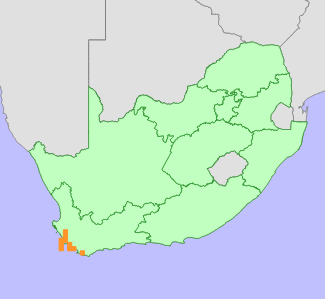|
Scientific Name | Erica capitata L. |
Higher Classification | Dicotyledons |
Family | ERICACEAE |
Common Names | Kapokkie (a) |
National Status |
Status and Criteria | Near Threatened B1ab(iii,iv,v) |
Assessment Date | 2012/08/22 |
Assessor(s) | R.C. Turner & L. von Staden |
Justification | EOO 6379 km², 12 known locations remain of this formerly common and widespread species after more than 50% habitat loss and degradation due to urban expansion, crop cultivation and spread of alien invasive plants. This species is still abundant on the Cape Peninsula, where 90% of the remaining population is protected, but elsewhere on the lowlands, small, isolated subpopulations continue to decline. |
Distribution |
Endemism | South African endemic |
Provincial distribution | Western Cape |
Range | Cape Peninsula and Groot Hagelkraal to Mamre. |
Habitat and Ecology |
Major system | Terrestrial |
Major habitats | Peninsula Sandstone Fynbos, Overberg Sandstone Fynbos, Agulhas Limestone Fynbos, Hangklip Sand Fynbos, Cape Flats Sand Fynbos, Atlantis Sand Fynbos |
Description | Dry to marshy sandy lowland flats, and rarely sandy mountain plateaus. |
Threats |
| Erica capitata's habitat is already >50% transformed, predominantly due to urban expansion on the Cape Flats, as well as crop cultivation and alien plant invasion further north towards Malmesbury, however, habitat loss occurred over a period of more than three generations (this is a short-lived reseeder). Habitat loss, degradation and fragmentation due to urban expansion, expanding agriculture, and competition from alien invasive plants continues. |
Population |
Erica capitata is a formerly widespread and very common species, which has declined extensively on the sandy lowlands of the Cape Flats as well as the coastal flats between Pringle Bay and Stanford, with 50% of known subpopulations now locally extinct. It is however still abundant on the Cape Peninsula, where more than 90% of the remaining population occur in five subpopulations, one consisting of over 3500 plants, and most of these plants are protected within the Table Mountain National Park. On the lowlands however, small, isolated subpopulations of fewer than 200 mature individuals remain in small, severely degraded fragments where they continue to decline.
|
Population trend | Decreasing |
Assessment History |
Taxon assessed |
Status and Criteria |
Citation/Red List version | | Erica capitata L. | VU B1ab(iii,iv,v) | 2012.1 | | Erica capitata L. | VU B1ab(iii,iv,v) | Raimondo et al. (2009) | | Erica capitata L. | Rare | Hilton-Taylor (1996) | |
Bibliography |
Baker, H.A. and Oliver, E.G.H. 1967. Ericas in southern Africa. Purnell, Cape Town & Johannesburg.
Goldblatt, P. and Manning, J.C. 2000. Cape Plants: A conspectus of the Cape Flora of South Africa. Strelitzia 9. National Botanical Institute, Cape Town.
Hilton-Taylor, C. 1996. Red data list of southern African plants. Strelitzia 4. South African National Botanical Institute, Pretoria.
Raimondo, D., von Staden, L., Foden, W., Victor, J.E., Helme, N.A., Turner, R.C., Kamundi, D.A. and Manyama, P.A. 2009. Red List of South African Plants. Strelitzia 25. South African National Biodiversity Institute, Pretoria.
Schumann, D., Kirsten, G. and Oliver, E.G.H. 1992. Ericas of South Africa. Fernwood Press, Cape Town.
|
Citation |
| Turner, R.C. & von Staden, L. 2012. Erica capitata L. National Assessment: Red List of South African Plants version 2024.1. Accessed on 2025/10/24 |
 Comment on this assessment
Comment on this assessment

